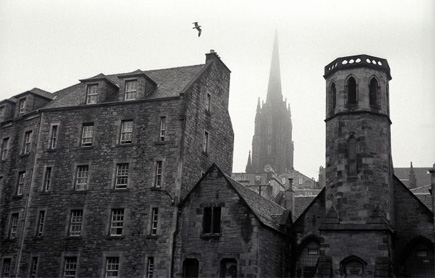 [Image: Edinburgh, as photographed by Jim Webb in 2002].
[Image: Edinburgh, as photographed by Jim Webb in 2002].There, "amidst the rocks of the Gobi," Padilla writes, Kirghiz nomads are taught "the exact height that Edinburgh Castle must attain, the precise length of the bridge that connects the High Street with Waverly Station, the correct calculations necessary to establish the perimeter of Canongate Cemetery, [and] the true distance between the two spires of St. Giles' Cathedral."
With that knowledge – and with lots of rocks – they construct "an elephantine fortress of streets, bridges, and windows." It is "a shimmering haze of towers" that blends in architecturally with the inferior mirages of the desert horizon.
Until it is buried by a sandstorm, then, this new, replicant Edinburgh functions as "a kind of global map in the very heart of the Gobi Desert," we read, "a vague though tangible diorama of the cosmos, its center a replica of the Scottish capital."
(See also Huangyangtan: or, Tactical geoannexation, Part II, at Pruned).
No comments:
Post a Comment